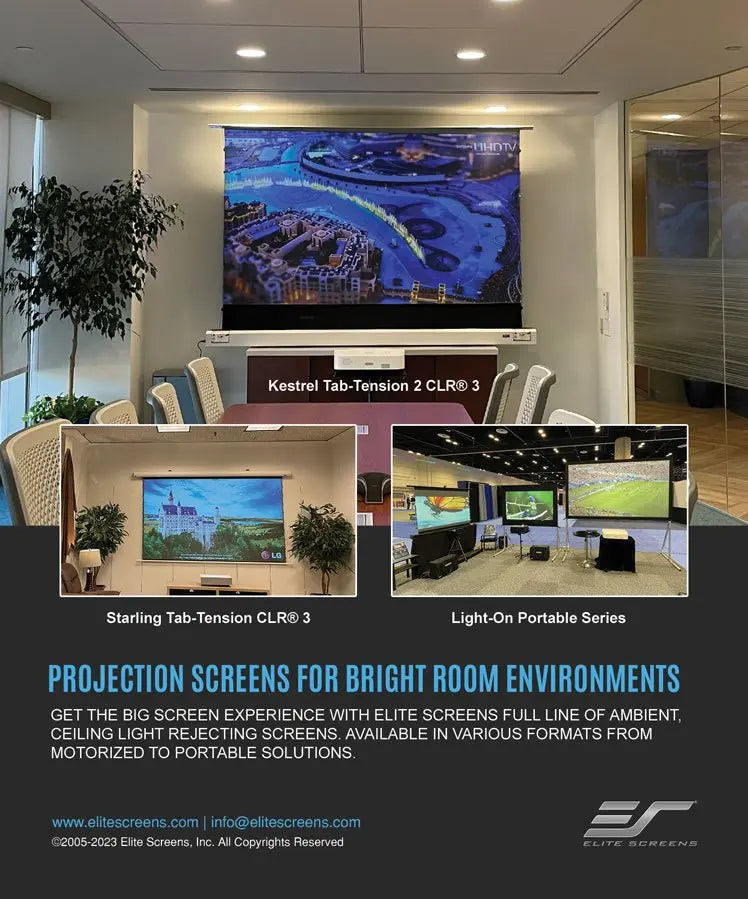Not all Laser TV Screens are built the same – we show the different types and quality standards in a tough manner
Laser TVs screens are all the rage for those who are looking for affordable life-size TVs, compared to which conventional TVs look downright "tiny". The area of application of Laser TV's is as flexible as it is impressive - whether in the ceiling, hidden in furniture or simply on the lowboard at home. However, there is one important component that should not be underestimated: The LaserTV screen , or as it was said at the beginning - the " Laser TV screen ". Because only the screen makes the picture - or is ultimately responsible for the fact that the picture projected by the Laser TV screens can also play out its full potential on it. Anyone who has gone from a white wall to a screen will know exactly what is meant here.

Or who fills up their sports car with diesel (quite apart from the question of who still fills up at these current horrendous prices, but that's a completely different topic)? The fact is, if you take Premium home with you, you also want to use Premium! And in this case a bare wall or even a white canvas is taboo. Because only the right LaserTV screen makes the big screen experience perfect!
But with the huge selection of different screens, the Laser TV buyer is often overwhelmed today and rightly so: If we take a look at Google, we are literally overwhelmed by the price war of cheap LaserTV screens (mostly from the Far East), who is to say which screen which one is suitable? More and more well-known manufacturers are throwing their own bundle packages onto the market, although the screens that come with them are often only inferior mass-produced goods.
The LaserTV screen must therefore be of the highest quality in order to achieve the optimum in picture quality. If you don't get the right advice from a specialist retailer or even order screens of inferior quality on the Internet, you are literally saving at the wrong end! In this article, we explain which types of LaserTV screens there are, what to look out for and which screens we can give our absolute recommendation after intensive testing.
CLR Screens

The best-known LaserTV screen is the so-called "CLR" screen, such as the high-contrast Starbright fabric from Elite Screens , which is often called the "bestseller" among LaserTV screens. But every screen shows its potential not only with the respective LaserTV itself, but also in connection with the room in which it is "irradiated". To be specific: CLR stands for Ceiling Light Reduction, i.e. light absorption from ceiling light. And in fact, in conventional living rooms, most of the interfering light comes from above, which these CLR special screens can largely prevent.
When used correctly, they allow great image plasticity even during the day in living rooms. But how do they do it? Like a classic screen, CLR LaserTV screens consist of two components: 1. the frame and 2. the cloth that is stretched over the frame. The advantage is that assembly is only done at home, which makes transport and handling child's play thanks to the low weight. The assembled screen is then hung on the wall like a picture. But when it comes to the cloth, CLR LaserTV screens differ massively from conventional screens:

The CLR cloth is not smooth, but consists of thousands of fine, horizontal lamellae, as can be seen in the picture. The highlight: The slats have a 45° angle between the LaserTV and the viewer and are colored white on this side, so they reflect the image projected from below directly in the direction of the viewer. On the other hand, i.e. the upper side of the slats, they are jet black and thus absorb the light from above. The steeper the incidence of extraneous light, the higher the absorption. The result is a dark gray basic color that enables a good black value and a high internal image contrast. It is obvious that this process is extremely complex in production and that a high quality of the cloth is therefore incredibly important.
In practice, this is implemented with high-quality brands such as the pioneering Elite Screens with the CLR screen Starbright 1:1. There is a great balance between black level, brightness and contrast. There are no disturbing side effects such as hotspots, the viewing angle is 180° and even beats most TVs. This cloth has already been awarded reference status in Asia and the USA. It is not a Chinese product, but comes from a special production in Taiwan, which has exclusively patented the coating (the application of the slats).
With many other CLR LaserTV screens, however, the situation is often different: A few things can go wrong here if you choose the wrong make and simply order freely on the Internet for the cheapest price. Here some examples:
Problem with cheap CLR screens - rippling

Since CLR LaserTV screens are made of a much stiffer material than conventional screen fabric, it is more difficult to stretch them evenly. This requires a combination of even tension and a stable frame. Savings are often made here with cheap brands, which leads to bumps and waves, which in turn is catastrophic with a LaserTV, as the entire image geometry is warped.
Problem with cheap CLR screens - temperature susceptibility

Slightly better designed brands show an even surface at first glance, but change over time due to material fatigue or temperature fluctuations: Flat image in winter, but waves in summer, as can be seen here!
Since the slats are made of plastic, they are sensitive to scratches. Inexpensive products are so sensitive that even gently rubbing your fingernails over them can lead to scratches and image errors.
Problem with cheap CLR screens - in-frame contrast
In addition to these practical aspects, there are also differences in image quality: In simple models, the slats are not exactly at a 45° angle and/or do not show perfect blackening on the upper side. As a result, little light is absorbed and the in-image contrast suffers, so it's no longer fun, as can be seen here from the cloth on the right that fell through the test grid.
On the left is the much “blacker” Elite Screens Starbright fabric . Thanks to their special coating, the disturbing reflected light is better absorbed by the ceiling, especially in daylight, but also in the evening with Hollywood blockbusters, and a reference black is produced at the same time. You can't achieve that with front projectors in combination with contrast screens in the living room.
So let's make it clear - A CLR LaserTV screen must meet the following criteria:
- Good black level
- pictorial plasticity
- Colorful picture
- Light weight
- Easy construction
- High-quality lamella structure (for good absorption of scattered light)
- Perfect flatness
- Geruchsneutral
- Contact person in Germany
Simply speak to the on-site specialists to see whether the screen you want meets these criteria.
By the way: CLR LaserTV screens are not only available as a frame version, but can now also be rolled up electrically like a screen! This is precisely what makes the use of LaserTV's incredibly flexible and ensures that there are no more unsightly black surfaces in the living room, which can hardly be avoided with conventional televisions. There are hardly any limits to the possibilities here and the giant TV can be integrated particularly elegantly or even invisibly in the stylish living room. We think: That's pure lifestyle!
These CLR LaserTV screens are available as a frame version with picture sizes from 90" to a gigantic 120", the motorized versions from 100"- 120" - this corresponds to a real home cinema size that makes conventional televisions look really old next to them.
Before you click on the order button, however, we warn you: Do not simply order any screens freely on the Internet - not even convincing screen supplements from many well-known manufacturers - because their screens are usually only bought from cheap Chinese suppliers. These often do not achieve the contrast qualities and brutal black level that can be achieved with a reference CLR such as the EliteScreens Starbright .


